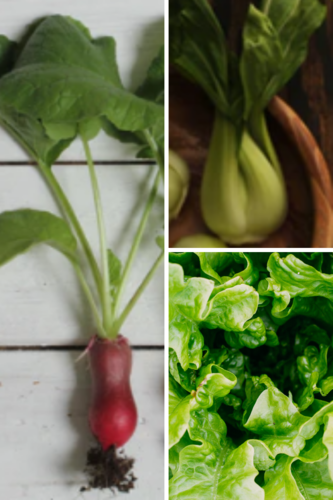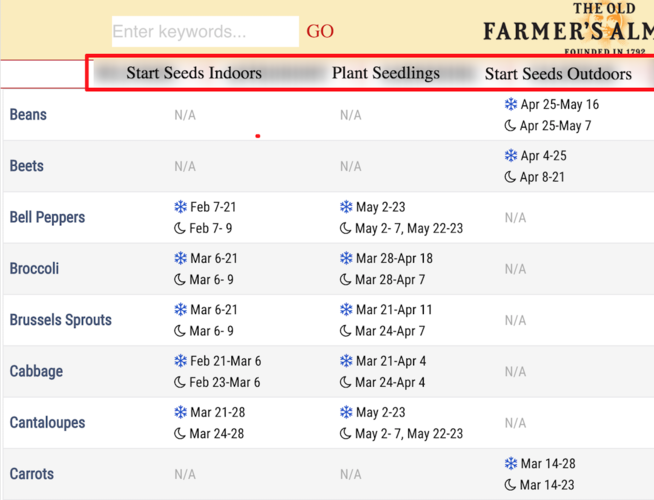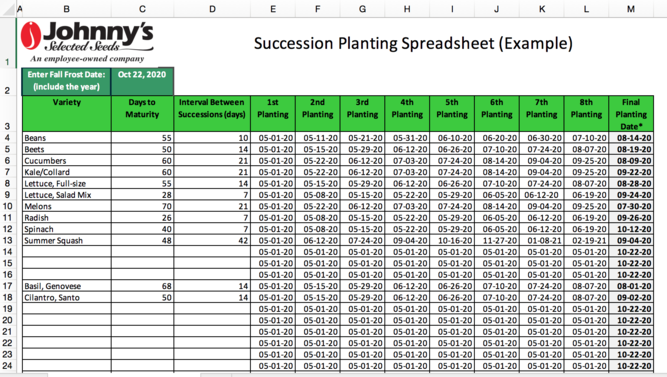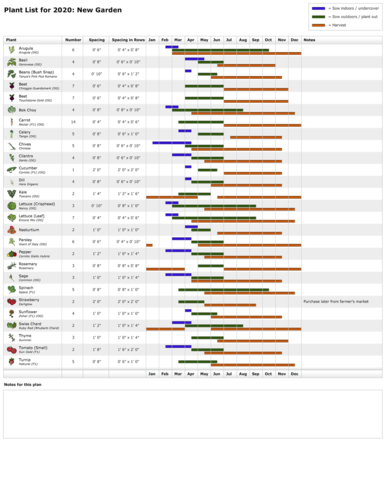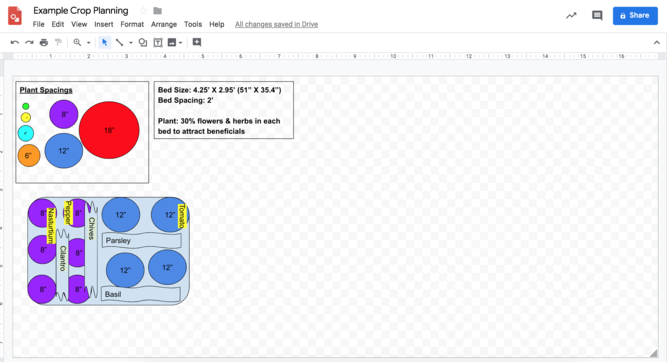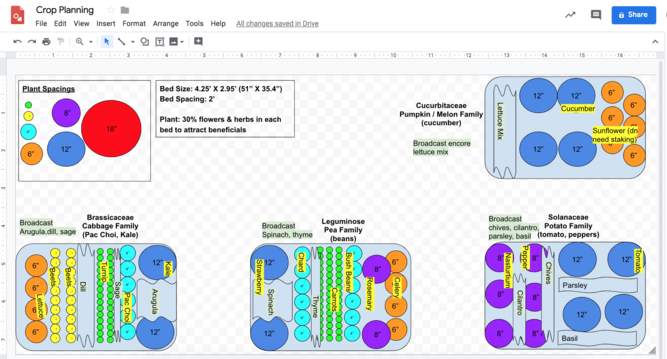It’s almost springtime and time to decide what vegetables you’ll want to grow outside. For this year’s garden we’re into vegetables that grow fast, have high yields, and do well in small spaces.
We will go into detail showing you exactly how we planned our garden this year. There are a lot of free (and paid) tools to simplify your garden planning.
Table of Contents
Vegetables That Grow Fast
- Fast-Growing Vegetables (meaning you can harvest in 28 days): radish, pac choi, lettuce mix, cress, sprouts, shoots
- High-Yield Vegetables: These won’t grow as fast as 28 days, but over time will provide a lot of produce. You can cut these every week and they will come back over time. These high-yield vegetables include chard (Swiss chard), kale, collards, oregano, mint, chives, sage, basil, parsley.
- Small Vegetables: Plant these around larger crops. Pack them in tightly. These vegetables may take longer to mature but are small, and great for making the most of small spaces. Consider growing spinach, arugula, celery, leeks, bunching onion, beets, turnips, dill, cilantro, thyme, and rosemary.
Vegetables That Grow (Somewhat) Fast
- High-Yield Vegetables: Takes 45-100 days from transplant (meaning you planted as seedlings) to harvest. These high-yield vegetables include: cucumbers, tomatoes (sun gold varieties). Summer squash and zucchini produce a lot too, but they are both very susceptible to pest and disease. If you want to plant these be alert of any unwanted pests early.
- Yield Significant Enough To Grow: Smaller carrots ready in about 55-60 days. Broccoli can grow as fast as 50-60 days from transplant. Peas & beans are ready 45 days from transplant. You’ll need to use a trellis for some varieties. There’s more effort to harvest these.
- Small Vegetables: Peppers, Hot peppers, Garlic (might harvest once only)
Choosing Vegetables That Grow Fast
Know your zone, your frost dates, and have a general understanding for plant families. All three are key for knowing what vegetables will grow fast in your climate.
Know Your Plant Hardiness Zone
The Plant Hardiness Zone tool allows you to type in your zip code and will show you which zone you’re in. This will help you understand vegetables and varieties well-suited for your climate.
As an example, we grow in zone 7a.
Know Your Frost Dates
This Frost Date Tool allows you to type in your zip code to see the average date of your last spring frost and your first fall frost.
These dates are important for gardeners as they signal the beginning and end of the gardening season.
Here are ours:
- Last Spring Frost Date for Our Location: April 18
- First Fall Frost Date for Our Location: October 22
- Total Growing Season: 186 Days
Know These Nine Plant Families
It’s not necessary to recognize 100% of the plant families. Knowing at least these nine popular ones will help you garden plan. It’s important because “species in the same plant family tend to have similar growth characteristics, nutrient needs, and often the same pests (pathogens, herbivores).”
- (Asteraceae) Daisy Family: Endive, Chicory, Artichoke, Sunflower, Lettuce, Tarragon, Calendula
- (Leguminosae) Pea Family: Peas, Beans
- (Chenopodiaceae) Beetroot Family: Beets, Spinach, Chard
- (Apiaceae) Carrot Family: Celery, Cilantro, Carrot, Fennel, Parsnip, Parsley
- (Alliaceae) Onion Family: Leek, Chives, Shallots, Garlic, Onion
- (Lamiaceae) Mint Family: Mint, Basil, Oregano,Marjoram, Rosemary, Lavender, Sage
- (Brassicaceae) Cabbage Family: Kale, Broccoli, Cabbage, Cauliflower, Brussel Sprouts, Watercress, Mustards, Pak Choi, Radish, Turnip
- (Cucurbitaceae) Pumpkin / Melon Family: Gourds, Watermelon, Cantaloupe, Cucumber, Pumpkin, Zucchini, Squash, Luffa
- (Solanaceae) Potato Family: Eggplant, Tomatillo, Tomato, Potato, Pepper
Tools For Planting and Planning
Planning your garden can seem daunting. We’ve listed some free and paid tools to help you this year.
Planting Calendar Example (FREE Farmer’s Almanac tool, image below): Best dates for planting vegetables and fruit in your garden! Calendar calculates the best time to start seeds indoors and outdoors. Also tells you when to plant young plants outside.
Planting Schedule Calculator (FREE Johnny’s Seeds tool, image below): Figures out the dates when it’s safe to plant early crops outside, based on the frost-free date that you enter.
Succession Planting Calculator (FREE Johnny’s Seeds tool, image below): Input the date of your first planting of each crop. The spreadsheet calculates the dates for later plantings if you want a repeat harvest throughout the season. This also allows you to input your first frost date, counting back the appropriate number of days to determine the last date to plant and still get a crop before frost.
Garden Planner from GrowVeg (PAID subscription after 7 day FREE trial; image below): Create a scaled garden model, choose your plants from the menu, and this tool will give you a detailed list of when to sow indoors, sow outdoors, and harvest times for each plant you decide to grow.
This is handy if you want a tool to auto-generate a calendar for you, so you’re not creating one from scratch.
Google Drawings (FREE if you have a Google account; image below): You can draw your own garden to scale and map out your plants and spacing. Rearrange as much as you’d like.
How To Decide What To Plant Together?
Consider these questions before deciding what to grow in your vegetable garden.
- Enjoy eating this a lot?
- Grows in our region?
- Unavailable at store/market
- High grocery price
- Small growing space
- Easy to cultivate and harvest
- Fast to maturity
- Repeat harvests
- High yield per harvest
- Less susceptible to pests/diseases
- Re-seeds itself
Use the plant families as a guide for knowing what to grow together.
For us, we used Google Drawing to label each raised bed with the biggest plant families.
We used the larger plant families as our anchors for each bed. These take up the most space in a garden, so it makes sense to start with these.
Large Plant Families To Start Your Garden:
- Brassicaceae or Cabbage Family
- Leguminose or Pea Family
- Solanaceae or Potato / Tomato Family
- Cucurbitaceae or Pumpkin / Melon Family
You may be able to fit a few large plants in each bed. Use up all the leftover space, and include smaller plants from the other families to fill the gaps in each bed.
In other words, companion planting maximizes the efficiency of your garden. Take smaller plants from the daisy, onion, beetroot, carrot, and mint families to pack in the plants and grow “bio-intensively.”
Bio-intensive agriculture is defined as an organic agricultural system that focuses on achieving maximum yields from a minimum area of land, while simultaneously increasing biodiversity and sustaining the fertility of the soil. The goal of the method is long term sustainability on a closed system basis.
– Garden City Harvest Source
Small Plant Families To Inter-Plant:
- Lamiaceae or Mint Family
- Alliaceae or Onion Family
- Apiaceae or Carrot Family
- Asteraceae or Daisy Family
- Chenopodiaceae or Beetroot Family
Companion Planting Guide
Not all plants grow well together. Use the companion planting guide below as you choose your crops for each bed.
There are so many ways to mix and match, so have fun with it!
| Plant | Good Companions | Bad Companions |
| Asparagus | Tomato, parsley, basil | |
| Beans | Potato, carrot, cucumber, cauliflower, cabbage, eggplant, summer savory, most other vegetables, herbs | Onions, garlic, gladiolus, chives |
| Beans, bush | Potato, cucumbers, corn, strawberries, celery, summer savory | Onions |
| Beans, pole | Corn, summer savory, sunflower | Onions, beets, kohlrabi, cabbage |
| Beets | Onions, kohlrabi | Pole beans |
| Cabbage Family | Aromatic plants, potatoes, celery, dill, hyssop, chamomile, sage, peppermint, rosemary, beets, onions | Strawberries, tomato, pole beans |
| Carrots | Peas, leaf lettuce, chives, onions, leeks, rosemary, sage, tomatoes | Dill |
| Celery | Leeks, tomatoes, bush beans, cauliflower, cabbage | |
| Chives | Carrots, tomatoes | Peas, beans |
| Corn | Potato, pea, beans, cucumbers, melons, pumpkins, squash | Tomato |
| Cucumbers | Beans, corn, peas, radishes, sunflowers, lettuce | Potatoes, aromatic herbs |
| Eggplant | Beans, potato, spinach | |
| Leeks | Onions, celery, carrots | |
| Lettuce | Carrots, radishes, strawberries, cucumbers, onions | |
| Melons | Corn, nasturtium, radish | |
| Onions (garlic) | Beets, strawberries, tomatoes, lettuce, summer savory, leeks, chamomile, pepper | Peas, beans |
| Parsley | Tomato, asparagus | |
| Peas | Carrots, turnips, radishes, cucumbers, corn, beans, most vegetables and herbs | Onions, garlic, gladiolus, potato, chives |
| Potato | Beans, corn, cabbage, horseradish, marigolds, eggplant | Pumpkins, squash, cucumbers, sunflowers, tomatoes, raspberries |
| Pepper | Onion | |
| Pumpkin | Corn | Potatoes |
| Radishes | Peas, nasturtium, lettuce, melons, cucumbers | Hyssop |
| Soybeans | Grows with anything | |
| Spinach | Strawberries, eggplant | |
| Squash | Nasturtiums, corn | Potatoes |
| Strawberries | Bush beans, spinach, borage, lettuce, onions | Cabbage |
| Tomatoes | Chives, onions, parsley, asparagus, marigolds, nasturtiums, carrots | Corn, kohlrabi |
| Turnips | Peas |
Companion planting benefits include:
- Shade regulation – Taller plants shade plants that can’t handle as much sun
- Natural supports – Sunflowers or other tall plant can act as a natural trellis
- Healthy soil – Some vegetables provide more nitrogen and others may bring nutrients from deep within soil up to more shallow plants
- Weed suppression – Planting intensively with a variety of crops suppresses weeds
Not only do you want to companion plant, you should also plant flowers and herbs in each bed.
You will help attract beneficial insects for pest control by planting 30% of your bed with flowers or herbs.
- Flowers and herbs Include: basil, chives, oregano, mint, sage, rosemary, thyme, lemon balm, lemongrass, dill, cilantro, garlic, yarrow, borage, nasturtium, echinacea, marigold, zinnias
You will help attract beneficial insects for pest control by planting 30% of your bed with flowers or herbs.
Laying Out Your Plants On Paper
We used Google Drawing below to create a map of our four raised garden beds.
Each bed is 4.25′ X 2.95′ and the beds are two feet apart.
Create markings for general plant spacings using colored circles. We had a different circle for plants that require 1″, 2″, 4″, 6″, 8″, 12″, 18″ of growing space.
From there, we drag and drop plants of varying sizes into each raised bed. It’s fun to move the circles around. We could swap bigger plants for smaller ones. We tried to fit in as many small plants as possible to maximize our growing space.
Even though the beds aren’t that large, we are able to fit in a ton of crops. We may have gotten a little ambitious. Way too excited here.
Use the companion guide above as a reference as you go along. As you pick out a crop, search for it on a seed site like Johnny’s. After you’ve found the variety you want to grow, look at the growing specifications for plant spacings. That’s how you’ll know which size circle to use in your drawings.
Vegetables tend to be similar in size. After you’ve made your first garden plan, you can reference it next year for plant spacings. This is helpful if you choose to plant a different variety.
You can see in the image below areas where we broadcast seeds. This is where we will scatter seeds like a carpet over an area. Over time these will grow very lushly in the beds. The idea here is to maximize the growing space as much as possible.
Crop Rotations
Save your drawings so that you can refer to them year after year. When you plan for your garden next year, you’ll want to rotate the beds and plant different crops in each.
Crop rotation is important. If you plant the same crops in one raised bed every year, the soil depletes of minerals for new plant growth.
Additionally, insects overwinter, meaning they wait out the winter season. When spring comes along, they come out and want to feast. If you rotate crops, these insects won’t be familiar with the new crop.
Finally, plant diseases may be in leaves, roots, or vines from the previous season. You prevent their growth again by planting new crops in that same bed.
Final Thoughts
Planning a vegetable garden requires a lot of preparation. We’ll be honest. This was not a fast or easy task at all. If garden planning is new to you, it will take practice and determination to see things through.
We’ve outlined steps to help you find vegetables that grow fast. We’ve then provided detailed ways to plan your garden this season.
All that you need to do is buy your seeds or seedlings and start planting!
Need some extra help to get started? Read about finding the perfect location for your garden or finding the right raised bed for your family.
Let me know what you’re planting this season in the comments.


